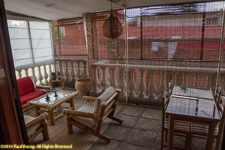
Antananarivo, formerly called Tananarive in French and usually referred to as Tana, is the capital and largest city in Madagascar. Historically it was the capital of the Merina ethnic group, Madasgar's largest. The city lies at an elevation of more than 4000' in the island's central highalnds. We stayed at the Pavillon de l'Emyrne, a 12-room boutique hotel in a 1930s-era house in old town Tana.
Rova:
Queen's palace (Palais de la Reine), built on the highest hill in Tana, accords a great view of Tana. The palace was gutted by a fire in 1995 and was still undergoing restoration. The palace gate is protected by a carved eagle, the symbol of military force, and a phallus, the symbol of circumcision and thus of nobility. The queen's palace, Manhakamiadana, was designed for Queen Ranavalona I. The royal tombs are to the left of the main gate.
City
Most of the old colonial buildings are in the upper city.
Flower market
In central Tana, Lac Anosy has a causeway to an island with a WW I memorial created by the French, Monument aux Morts (Monument to the Dead).
Across from the entrance to the causeway on the southern end of the lake is a daily flower market.
Lemurs' Park
Lemur's Park (Parc de lémuriens à Madagascar) is a small botantical garden and lemur reserve 22km southwest of Tana. It has nine free-ranging species of lemurs plus endemc plants. Most of the park's lemurs were confiscated pets, which are rehabilitated and bred for reintroduction to the wild. The park also provides environmental education to local primary school children and supports reforestation programs.
Tsimbazaza Zoo
Tsimbazaza Zoo (Parc Botanique et Zoologique de Tsimbazaza, or PBZT) is in southern Tana. It is the only zoo of its kind in Madagascar and hosts a large collection of Malagasy wildlife, as well as Aldabra tortoises and camels (a gift from Muammer Ghadafy). The pond has a large heron rookery.
Handicrafts market
The Royal Hill of Ambohimanga was the political center of the Merina people and of King Andrianampoinimerina, who united the island.
Tomb of King Andrianampoinimerina
The entrance to Ambohimanga village is a large traditional gateway, one of seven gates to the hilltop. To one side is a large flat stone which was rolled to seal off the gate from threats.
The fortress-palace (rova) was constructed of cement made from sand and egg whites. The outer walls alone required sixteen million eggs.
The blackened wood hut inside the compound, built in 1788, was King Andrianampoinimerina's "palace". Originally thatched, it now has a wooden tile roof. Photography inside is forbidden.
Behind the hut are the royal baths, where the king bathed once a year. Afterwards the bathwater was considered sacred and was delivered to his waiting supplicants.
Next to the king's hut is the summer palace of Queen Ranavalona I, who ruled from 1828 to 1861. It has the original European-style furniture inside.
Ambohimanga is still considered a sacred site. You will see zebu horn offerings at shrines around the compound. It is taboo to point at the shrines with your finger outstretched. You must point with your knuckle.
©2016, 2017 Mermaid Underwater Photographic. All Rights Reserved.
Contact us at mermaid@underwater.org.
Last modified 24 October 2017